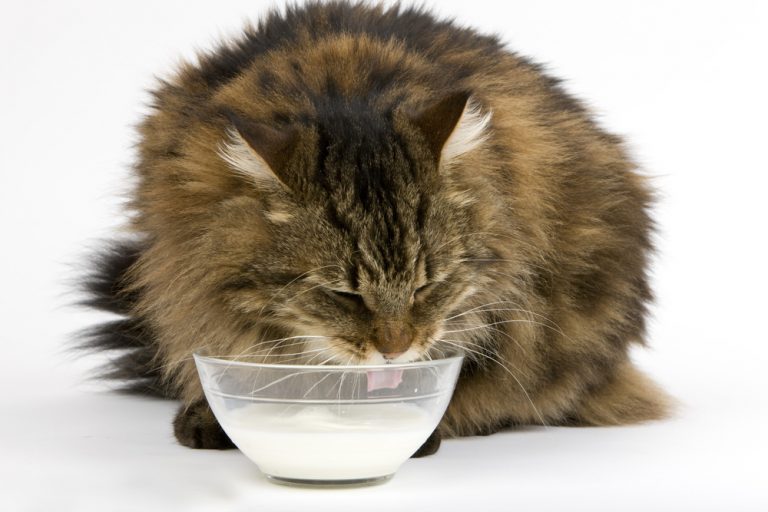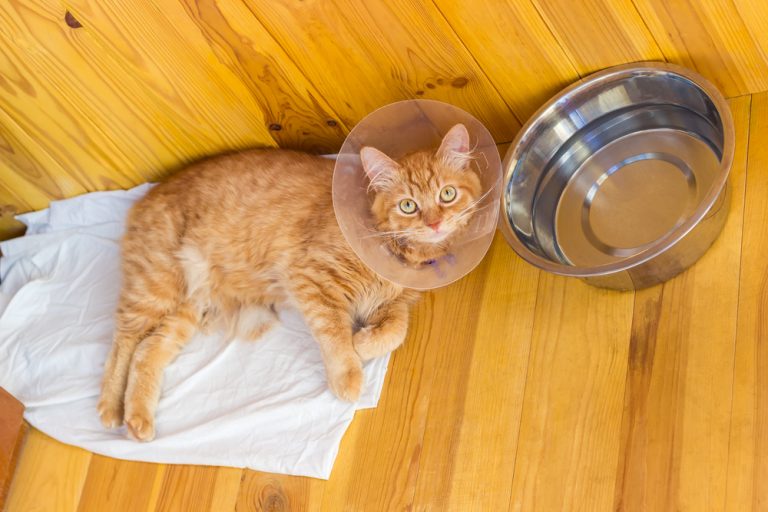Can Cats Eat Fish Skin? What is The Best Fish to Feed to Your Cats?
Cats love fish and anything relating to fish. It only makes sense to wonder: can cats eat fish skin and if so, which fish skin?
The answer is yes, cats can eat fish skin. The skin is packed with nutrients that support a cat’s optimal health. However, care should be taken to avoid mercury poisoning.
There are other important things that you should know before feeding your catto some skins. I’ll go through them in this blog post.
- Can Cats Eat Fish Scales?
- Can Cats Eat Fish Skin Raw?
- Can Cats Eat Dried Fish Skin?
- Can Cats Have Fried Fish Skin?
- Can Cats Eat Smoked Fish Skin?
- Can Cats Have Raw Salmon Fish Skin?
- What Are the Benefits of Feeding Fish Skin for Cats?
- 1. Fish Skin Is a Natural Source of Omega-3 Fatty Acids
- 2. Fish Skin Can Help to Reduce Inflammation in Your Cat’s Body
- 3. Fish Skin Is a Natural Source of Protein and Other Nutrients
- 4. Fish Skin Is a Low-fat Treat for Cats
- 5. Fish skin can help to prevent hairballs in cats
- 6. Fish Skin Can Help to Improve Joint Health in Cats
- How Can You Give Your Cat Fish Skin?
- How Should You Store and Serve Fish Skin Treats for Cats?
- How to Give Your Cat Fish Skin?
- How Much Fish Skin Should I Give My Cats?
- What to Consider Before Giving Your Cat Fish Skin?
- FAQ
Can Cats Eat Fish Scales?
Cats can eat fish scales, although they may not want to. The scales can be sharp and unpleasant to eat and could be a choking hazard for cats.
Can Cats Eat Fish Skin Raw?
Cats should not eat raw fish skin. Raw seafood poses potential heavy metal poisoning. Depending on the type of fish, the levels of mercury vary. Larger fishes tend to have a higher concentration than their smaller counterparts.
Fish with potentially high mercury content include tuna, sharks, swordfish, and mackerels.
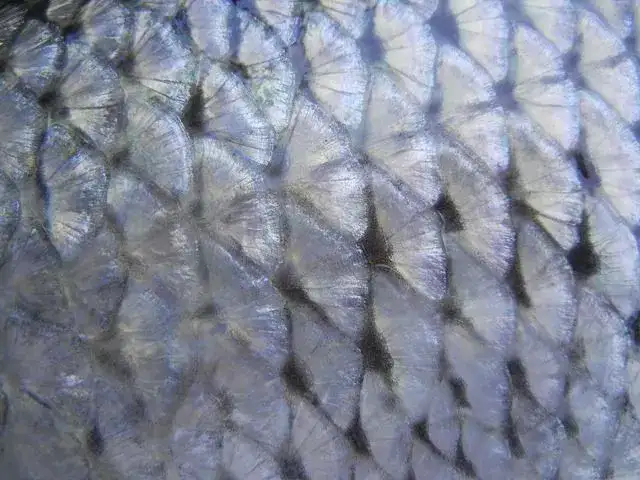
Can Cats Eat Dried Fish Skin?
Cats can eat dried fish skin safely. In fact, some cats will prefer it to wet fresh skin. Dried fish skin can be used as a training treat or part of your pet’s regular meal
Can Cats Have Fried Fish Skin?
Cats should not have fried fish skin. Fried foods are unhealthy for kittos. The fried skin normally has a lot of fat and grease which can lead to cat obesity.
Additionally, fried skin has trans fats which are bad news for your catto’s heart health.
Lastly, it is highly likely that the fried fish skin will be high in salt. Too much salt can cause dehydration and electrolyte imbalances in cats.
Therefore, it is best to give your cat only a small piece of fried fish skin, if any at all.

Can Cats Eat Smoked Fish Skin?
Cats can safely eat smoked fish skin. It’s relatively low in calories, making it a good choice for cats who are trying to lose weight or maintain a healthy weight.
However, only feed your kitto some smoked skin in moderation. This is because it has a lot of salt from the brine. Too much sodium causes dehydration, spasms, and seizures.
Can Cats Have Raw Salmon Fish Skin?
Cats can eat raw salmon skin. They love the taste of salmon skin that has been sliced and served raw.
But should they eat it? A resounding no. Cats should not eat raw salmon skin as it may be contaminated with harmful bacteria and parasites.
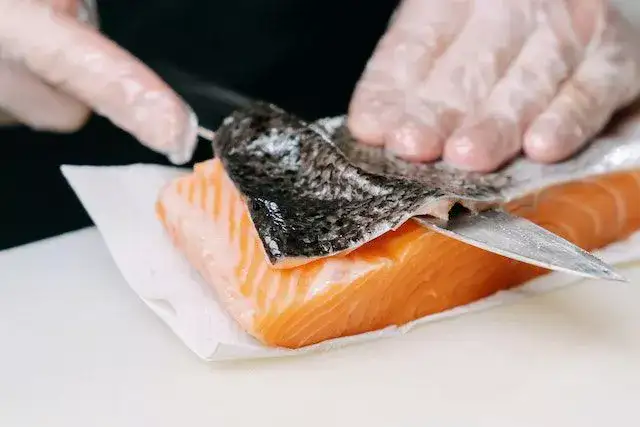
Store-bought raw fish is more likely to contain these harmful agents than freshly caught fish, and so it is best to avoid giving raw salmon skin to cats altogether.
If you do want to give your cat some salmon skin, cook it separately first to destroy any harmful enzymes that may be present.
At any given time you should avoid feeding your cat raw fish products. To understand how to safely feed your kitto some raw fish check out my post on cats eating sushi and raw fish.
And if you have some extra seafood that you want to give to your cat, make sure to check out each component to see if your cat can eat it, like can cats eat crabs, lobsters or squid?
Is Salmon Skin Healthy for Cats?
Salmon skin is healthy for cats as long as it’s cooked properly. It has many of the same benefits as salmon meat.
Salmon skin is high in Omega-3 fatty acids, which may have benefits for your cat’s health, including anti-inflammatory properties and healthier skin and fur.
Salmon is one of the common fish types to feed your catto. This is why I wrote a whole post explaining how cats can eat different salmon types safely.
If your cat has any health issues that you think may be helped by adding Omega-3s to their diet, talk to your vet.
What Happens If Cats Eat Salmon Skin
Salmon skin is a great source of nutrients for your cat and won’t harm them in any way. The skin is full of healthy nutrients for your kitto’s health.
There’s no need to worry about your cat choking on salmon skin either, as it’s not much of a choking hazard.
What Are the Benefits of Feeding Fish Skin for Cats?
1. Fish Skin Is a Natural Source of Omega-3 Fatty Acids
Fish skin is a good source of omega-3 fatty acids, which are beneficial for maintaining healthy skin and fur.
The fatty acids can help keep the coat shiny and healthy and the skin supple and hydrated.
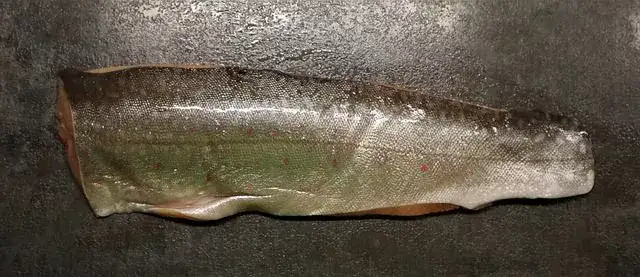
Cats fed a diet supplemented with omega-3 fatty acids have a significant decrease in inflammation and an increase in skin moisture.
Omega-3 fatty acids may also help to prevent or treat other conditions such as arthritis, heart disease, and kidney disease.
But that’s not all. A study on the role of dietary omega-3 and 6 found that fatty acids help prevent the prevention of cancers and cardiac arrest.
2. Fish Skin Can Help to Reduce Inflammation in Your Cat’s Body
Fish skin contains omega-3 fatty acids, which can help to reduce inflammation in your cat’s body.
Omega-3 fatty acids help to keep the coat shiny and healthy and the skin supple and hydrated.
Feeding cats a diet rich in omega-3 fatty acids improved the health of their skin and coat.
3. Fish Skin Is a Natural Source of Protein and Other Nutrients
Fish skin is a good source of protein for cats. A diet high in protein has benefits for their skin and fur.
Cats need protein to maintain their body condition and to support their normal growth and development.
Salmon skin is also a good source of protein and vitamins A and D.
4. Fish Skin Is a Low-fat Treat for Cats
Fish skin is a low-fat, nutritious treat that contains protein, omega-3 fatty acids, and collagen.
Here’s the deal, you always want to feed your cat some low-fat food. Cat obesity is not something you’d want your catto to experience.
It reduces the quality of life and increases their chances of diabetes.
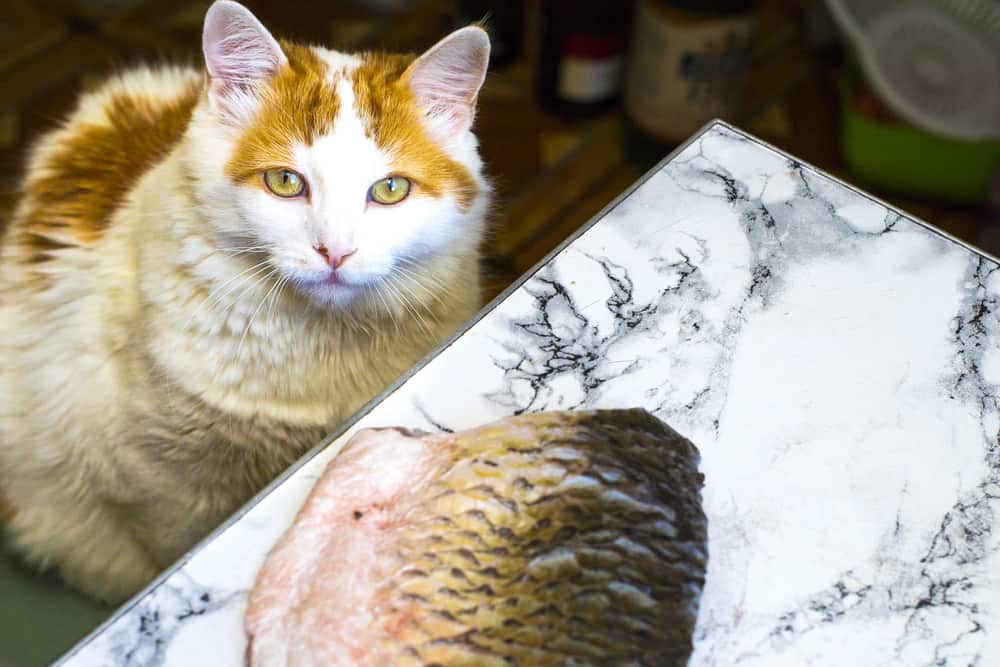
5. Fish skin can help to prevent hairballs in cats
Fish skin is loaded with essential oils and fat that can help your kitto with hairballs. But that’s not all.
Fish skin also contains a protein that helps to coat the stomach and intestines, which can help to reduce the amount of hair that is shed and ingested.
6. Fish Skin Can Help to Improve Joint Health in Cats
Fish skin oil is great for your kitto’s joint health. According to the VCA animal hospital, omega fatty acids contain components essential for the treatment of arthritis.
Cats also fed a diet supplemented with omega-3 fatty acids experience a significant decrease in inflammation.
How Can You Give Your Cat Fish Skin?
You can give your cat fish skin in 3 ways; raw. cooked or freeze-fried. Cooked fish skin is the best option as parasites are killed. Keep it simple and only boil the skin without spices.

Can cats eat lobsters? Find out everything you need to know
How Should You Store and Serve Fish Skin Treats for Cats?
To store fish skin treats, place them in an airtight container in the fridge. They will stay fresh for up to 2 weeks. When you’re ready to serve the treats, they can be given at room temperature or cold.
If you’re feeding them to a kitten, cut the pieces into small bite-sized pieces so they don’t choke. Older cats can eat the whole treat.
After 15 minutes, any uneaten fish skin treats should be thrown away as they will start to spoil.
How to Give Your Cat Fish Skin?
It’s really important that you give your cat fish skin properly. Here are 5 steps on how you can do it.
1. Choose a Safe One Without Heavy Metals
Salmon skin is a good option for cats because it is high in omega-3 fatty acids.
Other types of fish skin, such as cod skin, may not be as beneficial for cats.
Ask your veterinarian for guidance on which fish skin to give your cat.

2. Prepare the Fish Skin
Clean the fish skin to remove any dirt or debris. Cut the skin into small pieces that are easy for your cat to eat.
3. Give Your Cat the Fish Skin
There are different ways to give your cat fish skin, depending on your preference.
If you give them raw fish skin, be sure to monitor them so they don’t choke on it. If you give them cooked or freeze-dried fish skin, there is no need for supervision.
4. Store the Fish Skin Properly
To store fish skin properly to give to your cat, raw fish skin should be stored in the refrigerator and used within 3 days.
Cooked or freeze-dried fish skin can be stored at room temperature and used within 6 months.
5. Dispose of the Fish Skin Properly
Fish skin should be disposed of carefully to keep other animals from being attracted to the scent.
The best way to do this is to compost it or throw it away in the trash.
How Much Fish Skin Should I Give My Cats?
A general rule of thumb is to give 1-2 inches (2.5-5 cm) of fish skin per day. However, the amount of fish skin you give your cat will depend on their age, weight, and health.
Kittens and senior cats need less than adult cats. Cats who are overweight or have health conditions will also need less than healthy adult cats.
If you’re not sure how much to give your cat, ask a veterinarian for guidance.
What to Consider Before Giving Your Cat Fish Skin?
Before giving your cats fish skin, make sure to consider this:
1. The Type of Fish Skin
Fish skin is a great source of omega-3 fatty acids for cats.
However, not all fish skin is created equal. Some types, like cod skin, may not be as beneficial.
Ask your veterinarian which type of fish skin is best for your cat.
2. The Size of the Fish Skin
There are a few things to consider when determining how much fish skin to give your cat.
Their age, weight, and health will all play a role in how much they need. The average cat needs 1-2 inches (2.5-5 cm) of fish skin per day.
However, always ask your veterinarian for guidance on how much is appropriate for your cat specifically.
3. The Age of the Cat
As cats age, they become better able to digest fish skin. Kittens under 1-year-old are not able to digest fish skin and may become ill from eating it.

Cats between 1 and 7 years old can digest fish skin but may still get sick.
Cats between 8 and 11 years old can digest fish skin but may still get sick if they eat too much at once. Therefore, age is an important factor to consider before giving your cat fish skin.
4. Whether the Cat Has Any Allergies
Cats can be allergic to fish, so it’s important to be aware of this before feeding your cat any seafood.
There is no one-size-fits-all approach to diagnosing a cat’s fish allergy, and it can take a long time to figure out which foods are causing problems.
The best way to avoid an allergic reaction from fish for your cat is to feed them a diet that eliminates all seafood completely.
5. Whether the Cat Has Any Medical Conditions
Before giving your cat fish skin, you should consult with their veterinarian.
Salmon oil supplements can be given to cats, but only after approval from a medical professional.
This is because there are some medical conditions that could be worsened by the addition of salmon oil to their diet.
For example, if your cat has diabetes, the extra oil could lead to weight gain and difficulty regulating blood sugar levels.
If you’re unsure about whether or not it’s safe to give your cat fish skin, always err on the side of caution and speak to a veterinarian first.
FAQ
Can Kittens Eat Fish Skin?
Kittens need to eat more fish skin than adult cats in order to get enough thiaminase.
Thiaminase is an enzyme that breaks down thiamine, and kittens need thiamine to develop properly.
Too much fish skin can cause a deficiency in thiamine, which can lead to neurological problems.
Can Cats Eat Fish Bones/ Salmon Bones?
Cats cannot eat fish bones because they can be a choking hazard. Raw fish bones can contain thiaminase, which breaks down thiamine, making it dangerous for cats to consume.
Cooked fish bones are less dangerous than raw fish bones, but they can still be a choking hazard.
Can Cats Eat Cooked Salmon Skin?
Cats can eat cooked salmon skin. When feeding cats salmon, cook the skin without oils, seasonings, or other ingredients to give your cat some healthy skin.
Can Cats Eat Sardines?
Cats can safely eat sardines. These little fishes are packed with omega fatty acids. They are also an excellent source of protein.
There’s a lot that goes into feeding your cat some sardines that I can’t fully discuss here.
You can check out my blog post discussing the topic of cats eating sardines.
Can Cats Eat Squids?
Cats can safely eat squid. Cooked squids have a rubbery texture and can choke your kitto so you should avoid giving it to your cat.


